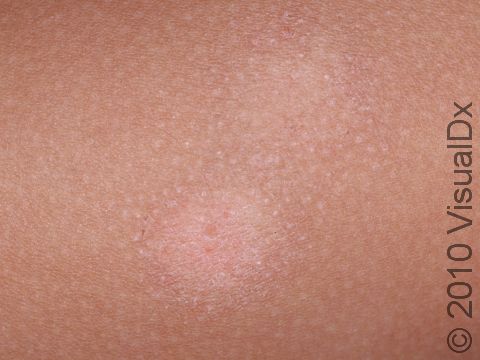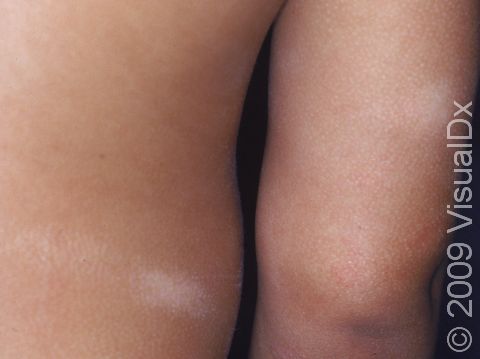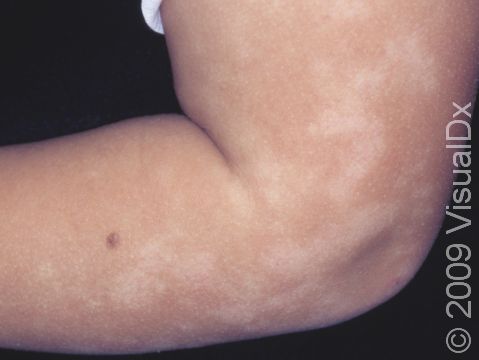Pityriasis Alba
Pityriasis alba is a common skin rash that occurs mainly in school-aged children. The rash of pityriasis alba appears as round or irregularly shaped, light-colored (hypopigmented) patches that have a thin scale and may be itchy. The lesions are common on the face (especially the cheeks), neck, and upper arms and legs, and they may be one-half inch to several inches in diameter.
The cause of pityriasis alba is not clear, but it appears to be worse with dryness, heat, and other stress to the skin. It is not contagious. The lesions of pityriasis alba may disappear only to reappear until approximately 1 or more years after the rash began. Once the rash is entirely resolved, normal pigmentation will reappear several months later.
Who's At Risk?
Pityriasis alba is most common in children aged 3-16 years, but it can be seen in infants, especially those with chronic dry skin or who have eczema, allergies, or asthma. Pityriasis alba is equally common in males and females. It can occur in people of any race / ethnicity, but it is most obvious in darker skin colors due to the contrast between the pityriasis alba patches and the surrounding skin.
Signs & Symptoms
Pityriasis alba appears as several (2-20) light-colored (hypopigmented) patches ranging in size from 0.5-5 cm. The patches may have overlying scale. Occasionally, pityriasis alba patches are mildly itchy. There is typically a distinct border around the patches, and the shape may be round or irregularly shaped.
The most common locations for pityriasis alba include the:
- Cheeks, around the mouth, and chin.
- Forehead.
- Neck.
- Shoulders, upper chest, and upper arms.
Pityriasis alba can become more obvious in the summer as the normal surrounding skin becomes darker with UV exposure.
Self-Care Guidelines
If you suspect your infant has pityriasis alba, the most important self-care measure is to keep their skin well hydrated, such as by:
- Using nonsoap cleansers or moisturizing soaps (eg, Dove Sensitive Skin Beauty Bar).
- Applying fragrance-free ointments such as petroleum jelly (Vaseline) or moisturizing creams (eg, CeraVe Moisturizing Cream) to damp skin after bathing.
It is also helpful to avoid potential triggers such as heat, humidity, heavily scented detergents or soaps, abrasive clothing, smoke, and stress.
Applying over-the-counter hydrocortisone cream sparingly for 3-7 days can help relieve itch, if present.
Treatments
Your baby’s medical professional may scrape some of the scales onto a slide and examine them under a microscope to make sure the rash is not a fungal infection.
Pityriasis alba is a harmless condition that usually goes away on its own with time, so no treatment may be necessary. However, your child’s medical professional might recommend further self-care measures to help improve the appearance of the affected areas, such as by keeping the skin moisturized.
In severe, widespread infections with pityriasis alba, the medical professional may recommend prescription-strength corticosteroid (cortisone) cream.
Visit Urgency
Call your baby’s medical professional for evaluation if the condition does not improve with self-care measures, if it seems to be getting worse, or if it spreads to other areas.
References
Bolognia J, Schaffer JV, Cerroni L. Dermatology. 4th ed. Philadelphia, PA: Elsevier; 2018.
James WD, Elston D, Treat JR, Rosenbach MA. Andrew’s Diseases of the Skin. 13th ed. Philadelphia, PA: Elsevier; 2019.
Kang S, Amagai M, Bruckner AL, et al. Fitzpatrick’s Dermatology. 9th ed. New York, NY: McGraw-Hill Education; 2019.
Paller A, Mancini A. Paller and Mancini: Hurwitz Clinical Pediatric Dermatology. 6th ed. St. Louis, MO: Elsevier; 2022.
Last modified on June 18th, 2024 at 1:30 pm

Not sure what to look for?
Try our new Rash and Skin Condition Finder



